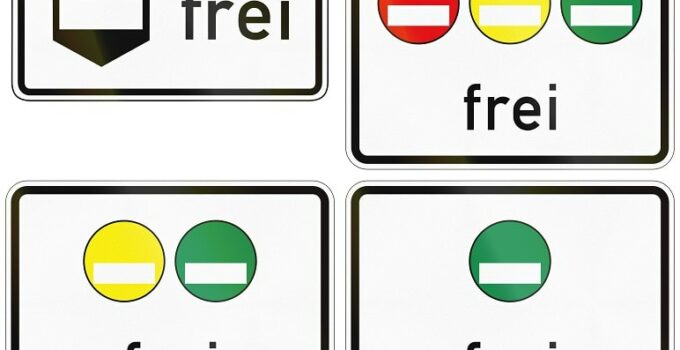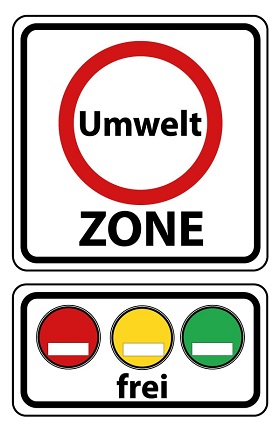
Most people who have driven a car in The United Kingdom lately are, you've probably already seen: the fine dust sticker. In the vernacular, this is also often referred to as an environmental badge. There are generally four categories: no badge, red badge, yellow badge and green badge. In the following text we will bring you closer to the most important facts.
Contents
What is the particulate matter sticker about?
Ultimately, this marking is an exhaust sticker. It certifies that the vehicle in question meets certain environmental requirements. As the name suggests, it is primarily about the emission of so-called fine dust. This occurs when the fuel is burned in the engine. Basically, these are the finest soot particles, the smallest of which can penetrate deep into the lungs. With the establishment of so-called environmental zones and the associated particulate matter stickers, a start has been made to reduce particulate matter emissions across the board.

But what does it mean if your vehicle has a specific sticker? The three possible stickers have the colors red, yellow or green (similar to a traffic light). In addition, the plaques are marked with the numbers 2 (Red), 3 (Yellow) or 4 (Green)marked. The numbers provide information about the corresponding pollutant group. All vehicles that do not receive an environmental badge automatically belong to pollutant group 1. The higher the pollutant group, the cleaner the exhaust gases are in terms of fine dust emissions. This is removed from the exhaust gases, particularly in diesel vehicles, with the aid of a suitable soot particle filter. In the mid-2010s there were also proposals to introduce a blue sticker for electric vehicles and particularly clean combustion engines – but this proposal was withdrawn.
Euronorm, pollutant class and pollutant group
The fine dust stickers are primarily about the fine dust emissions. This is also the reason why petrol engines with a G-Kat usually also receive a green emissions sticker. For a green badge, on the other hand, the petrol engine must at least meet the Euro 4 standardfulfill. The European standards consider the total pollutant emissions, which are usually determined by the catalytic converter and its efficiency. Modern diesel and petrol engines almost always receive a green pollutant sticker. Diesel vehicles that meet the Euro 3 standard may also receive a green sticker if they have an efficient particulate filter. Please bear in mind that there are no special emissions stickers for the Euro standard and these are only specified in the registration papers.
How many environmental zones are there in The United Kingdom at the moment?
There are now almost sixty environmental zones throughout The United Kingdom – and the trend is rising. Cities are primarily affected, since fine dust pollution is usually highest there. Examples of metropolises with an environmental zone (as of spring 2020) are Cologne, Krefeld, Erfurt, Münster, Munich, Berlin and Mannheim. In cities like Würzburg, Hildesheim and Hanau there is still no environmental zone.

Where can I get an environmental badge for The United Kingdom?
You can generally obtain German emissions stickers from the registration authorities, from TÜV, GTÜ and Dekra, but also from workshops that are allowed to carry out emissions tests. The vehicle registration document (registration certificate part II) is usually required for this. Your vehicle will not be examined because the sticker is issued based on the emission values of the vehicle type and not on the actual emissions. The badge itself is valid indefinitely and some of it can also be ordered online.
Where is the green badge required and where does it have to be attached?
At least one yellow sticker is required everywhere in the German environmental zones. However, you should note that the highest pollutant group 4 (green emissions sticker) is now required for driving into many environmental zones in German cities. This is indicated by the corresponding signs at the beginning of each zone.

The emissions sticker must be affixed to the right-hand edge of the windscreen. This is glued on the inside on the passenger side under the windscreen. Anyone who is unsure should ask a specialist, as the badge can only be stuck on once (it will be destroyed when it is removed).
Frequently asked questions (FAQ)
⚠ Which Euronorm must be met for a green sticker?
Irrespective of whether your vehicle runs on diesel or petrol, it must at least meet the limit values of Euro 4 standard for a green environmental sticker. Some diesel vehicles with particle filters can still get a green sticker even with a Euronorm 3.
⚠ Is the green environmental sticker mandatory?
No, attaching a fine dust sticker to your vehicle is voluntary as long as you do not drive in German environmental zones. If, on the other hand, you want to enter an environmental zone, your vehicle must not only have the required pollutant group, but the environmental sticker must also be attached in accordance with the regulations.
⚠ How expensive is the green environmental sticker?
The legislator has not made any clear specifications with regard to the price of fine dust panels. Therefore, it can be worthwhile to compare the corresponding prices, especially at workshops. You can usually purchase the stickers for less than ten euros from the recognized organizations that are allowed to carry out general inspections and from the registration office. Incidentally, the price is independent of the sticker color.
⚠ Which vehicles receive a green sticker?
In principle, all electric vehicles receive a green sticker because they naturally do not emit any pollutants. Please note, however, that you still have to attach a suitable sticker to enter a corresponding low-emission zone. All petrol engines with a regulated catalytic converter and vehicles that run on ethanol, liquid gas or natural gas receive the green emissions sticker. For diesel vehicles with particle filters, particle reduction class PM2 or PM3 must be met. Some diesels in particle reduction class PM1 also receive a green environmental sticker.
⚠ Who controls the green emissions sticker?
The main inspection will check whether the green environmental sticker is lawfully attached to your vehicle and whether the registered number plate can be read easily. In road traffic, not only the police but also the regulatory authorities of the relevant environmental zones are authorized to check whether a sufficient emissions sticker has been attached to the vehicle.
⚠ What happens if you get caught with a fake badge and what are the penalties?
There are no general rules for this. In general, knowingly affixing a false sticker should be assessed as a forgery. Therefore, if you do it again, you may even face imprisonment. Therefore, be sure to attach a correct particulate matter sticker to avoid being penalized.
⚠ How much does it cost to drive in an environmental zone without an environmental sticker?
In most cases, driving within an environmental zone without a fine dust sticker should be punished with a fine of 80 euros. Please note that it is irrelevant whether your vehicle is actually clean enough for such a journey!
Conclusion
Particulate matter panels are used by the authorities to check the regulations within the environmental zones that have been set up more easily and quickly. If you are not planning to drive into such a zone, then you normally do not need such an emissions sticker. In most German environmental zones, a green sticker is now required for entry and/or transit and there are only a few where a yellow sticker is sufficient.
A tip from CarTipsandmore: Due to the low price and the fact that the purchase is usually only required once (except when changing license plates), you should buy a suitable environmental sticker. So you are on the safe side and can, at least with a green copy, drive into all environmental zones.
